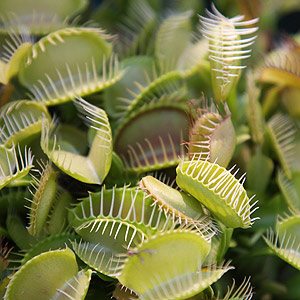The Venus Fly Trap
The single species genus Dionaea is famous for its single member, the Venus Fly Trap which is Dionaea muscipula.
This is the easy care and most popular of all of the carnivorous plants and incredibly popular with kids around the world.
The plant is originally from North Carolina and it comes from somewhat swampy areas, it the wild it lives on nutrients from the soil and air as do most plants, however it supplements this with a the ability to trap extra food in the form of insects.
The teeth like jaws are triggered to shut when an insect touches the fine hairs inside, and that is the end of the insect.
Now each plant has a number of ‘traps’ and they will come and go, so sometimes they just turn a blocky brown and drop of, but new ones will grow.
Top Tips
- Never let the Venus Fly Trap dry out.
- Always use fresh water with no contaminants.
- Always provide good light.
- Never fertilise the plant.
- Old leaves will naturally die back after it has caught an insect
- In winter the plat will die back, or go dormant.
- Do not set off the ‘Traps’ as this drains the plant of energy
- Repot in winter.
How To Grow The Venus Fly Trap
Being so easy to grow is the key to the popularity of the Venus Fly Trap. A damp root zone, lots of sun and of course as it comes from swampy areas, humidity. Many home growers use glass containers such as fish tanks where they can mimic the natural habitat. This is fine in cooler areas, however in warm climates the combination of glass and sun can make things a little to hot, so be careful.
You can also grow them outdoors in a container, in the cooler months partly cover with glass to keep them warm.
Many growers use sphagnum moss as a growing medium and this works fine, you will find it at good nurseries, Mitre 10, Home Hardware and Bunnings stores.
As for water, use rainwater if you can, or at least let the tap water sit for a day or two so the chlorine dissipates.
Feeding Your Venus Fly Trap
As for feeding, they generally find their own insects however you can feed them, small insects, they do not like big ones that much. They can turn black maybe indigestion, so small insects please. And no mince meat, thats another good way to kill them.
How and When To feed
If you are growing your Venus fly trap outdoors, you should not need to feed it at all, it is quite capable of catching its own insects.
If you are growing the plant indoors then it’s different.
You need to feed it small insects, the size is important. The insect needs to be small enough for the ‘trap’ to close. So small insects around 1/4 to 1/3 the size of the trap.
- Usually you will only need to feed from spring, through summer.
- You can use live or dead insects, live ones are better. Gently place them in the trap using tweezers, the movement of live insects will automatically cause the trap to close.
- Dead insects will not cause the trap to close so you need to use tweezers to put the insect in and move the insect around gently until you trigger the trap to close.
- Plants will have multiple traps, you only need to feed 2 – 3 of these every two weeks.
- Feed your Venus Fly Tray every 2 weeks, however they can go for longer.
You will find that individual traps will die after around 4 – 5 feeds, however they are usually replaced by new ones well before they die. - Insects that have killed with insect spray are not suitable.
Although it may seem like fun to cause the trap to close without feeding the plant, this will weaken the plant, so avoid doing this.
Propagation is by division of the clump of roots or from seed.
Problems
The plant dies back. This is natural, in winter the plants will die back for 3 – 4 months, and this is natural, it will spring back to life (in spring of course). Cut back the water a little during dormancy.
The plant arrives in a plastic container like a cloche, what do I do. They are sold this way because they are easier to get growing, however this is not a long term home, they need to be hardened off.
Varieties
Although only one species is registered the Venus Fly Trap is a variable species so along with hybridising a few different forms are available, care is the same for all.

